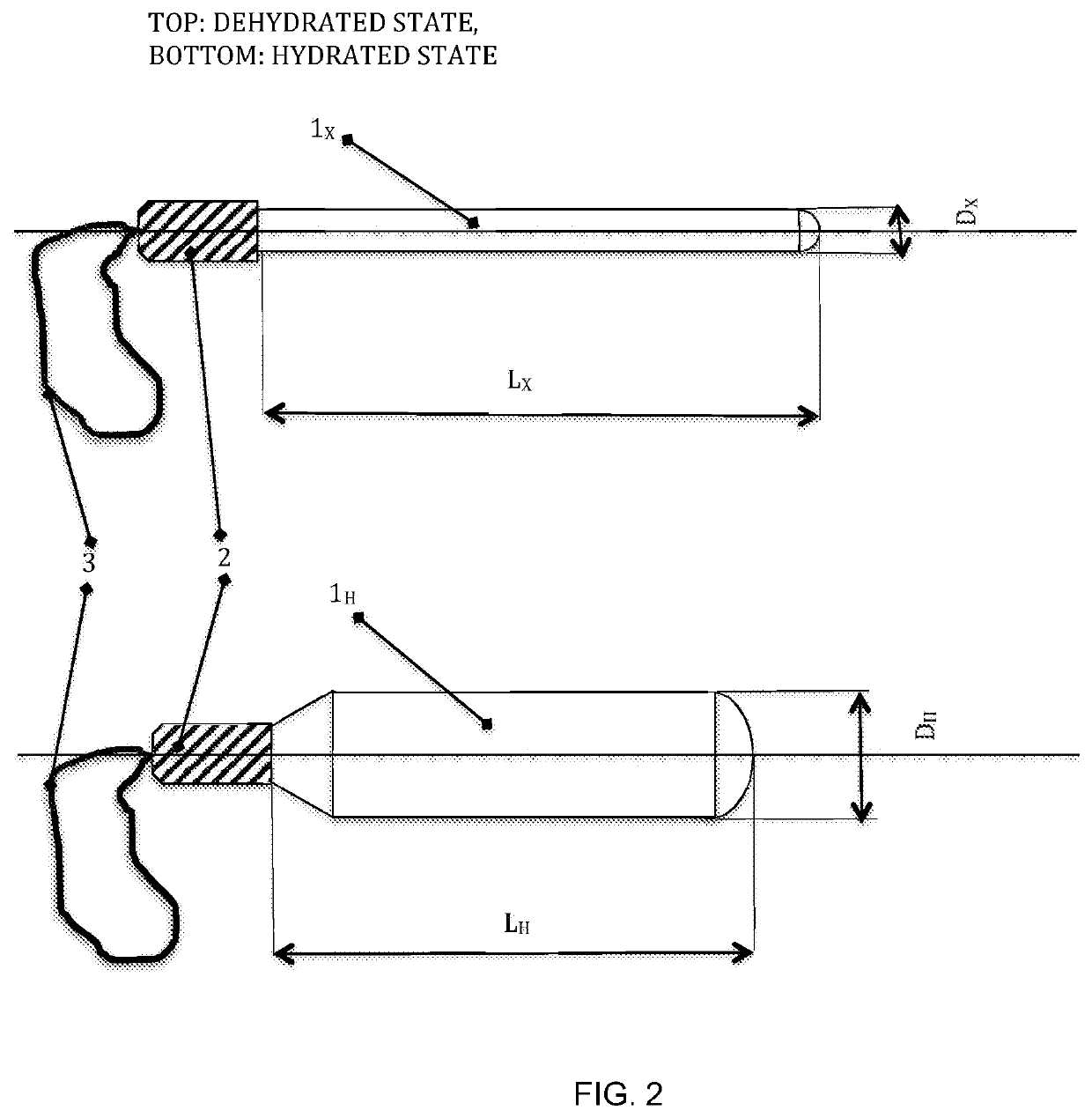Combined osmotic and hydrogel cervical dilators and method of making same
a cervical dilator and hydrogel technology, which is applied in the field of combined osmotic and hydrogel cervical dilators and making same, can solve the problems of reversible dehydration of tissue, and affecting the effect of osmotic and hydrogel dilators. , to achieve the effect of reducing the risk of osmotic and hydrogel dilating, reducing the risk o
- Summary
- Abstract
- Description
- Claims
- Application Information
AI Technical Summary
Benefits of technology
Problems solved by technology
Method used
Image
Examples
example 1
[0049]A hydrogel for the cervical dilator was prepared according to U.S. Pat. No. 6,232,406, which is incorporated herein by reference in its entirety. PAN of weight average molecular weight of 200,000 g / mol was dissolved in 55%-wt. NaSCN aqueous solution to form a 10%-wt. polymer solution. NaOH dissolved in 55%-wt. NaSCN aqueous solution was added at ambient temperature in an amount required for the PAN / NaOH mass ratio to be 1:10. Then, the solution was transferred into a jacketed tubular reactor, where it was heated to 70° C. for 60 hours. The resulting solution of the multi-block acrylic copolymer was cooled to 40° C. and transferred into a pressure vessel from where it was fed by a pressurized gas to a metering pump with a progressing cavity rotor. The solution was extruded through a cooled nozzle into a coagulation bath filled with NaSCN aqueous solution having an NaSCN concentration from 1 to 5%-wt. The coagulated hydrogel rod was washed until substantially all of the NaSCN wa...
example 2
[0054]Hydrogels prepared according to Example 1 were soaked with 10%-wt. aqueous solutions of the following monomers:[0055]1. sodium acrylate[0056]2. methacryloyloxypropane-1-sulfonic acid[0057]3. 4-vinylphenyl sulfuric acid[0058]4. vinylphosphonic acid.
[0059]After equilibrium was reached in each solution, the monomer-soaked hydrogel rods were stretched on drying racks similarly as in Example 1, and dried at 80° C. for 18 hours. Although no initiator was used and drying was performed in the presence of air, all monomers polymerized and an interpenetrating network of a polyelectrolyte within the multiblock copolymer hydrogel was formed. When swelled in isotonic solution, no elution of the polyelectrolyte was observed, because it is apparently firmly anchored within the hydrogel structure.
[0060]The xerogel stems could then be equipped with glued-on plastic handles and sterilized by irradiation or by a gas. FIG. 2 shows a cervical dilator in a dehydrated state (top drawing) and in a hy...
example 3
[0062]The hydrogel interpenetrating network from Example 2 with the poly(methacryloyloxypropane-1-sulfonic acid) monomer was soaked with excess of aqueous solution containing 5%-wt. of sodium sulfate, 3%-wt. of 1,2-propyleneglycol and 1%-wt. of tri-ethanol amine. Then, it was dried under radial tension at 70° C. until the residual water content reached approximately 18%-wt. Then, the product was cut to size, trimmed, equipped with handles and sealed in the sterilization pouches as in previous examples. The cervical dilator device was sterilized by electron beam at 40 kGy. This cervical dilator device provides for a fast cervix ripening with strong radial expansion and the capability to be shaped prior to insertion to fit any particular geometry of cervical canal.
PUM
| Property | Measurement | Unit |
|---|---|---|
| temperature | aaaaa | aaaaa |
| temperature | aaaaa | aaaaa |
| diameter | aaaaa | aaaaa |
Abstract
Description
Claims
Application Information
 Login to View More
Login to View More - R&D
- Intellectual Property
- Life Sciences
- Materials
- Tech Scout
- Unparalleled Data Quality
- Higher Quality Content
- 60% Fewer Hallucinations
Browse by: Latest US Patents, China's latest patents, Technical Efficacy Thesaurus, Application Domain, Technology Topic, Popular Technical Reports.
© 2025 PatSnap. All rights reserved.Legal|Privacy policy|Modern Slavery Act Transparency Statement|Sitemap|About US| Contact US: help@patsnap.com


